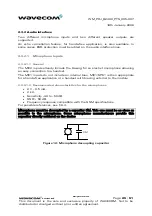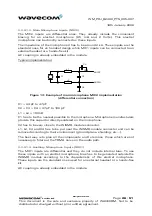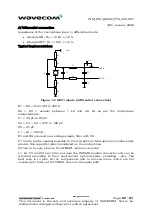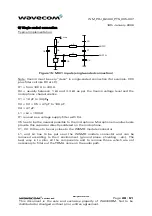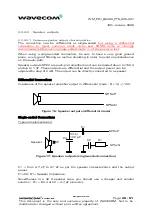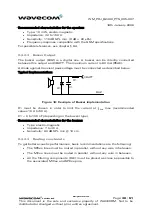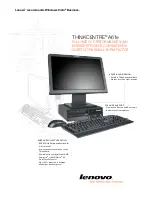
WM_PRJ_Q2400_PTS_005 -007
18th January 2006
Confidential©
All rights reserved
Page:
39
/
51
This document is the sole and exclusive property of WAVECOM. Not to be
distributed or divulged without prior written agreement.
Warning:
Wavecom strongly recommends to work with an antenna manufacturer either to
develop an antenna adapted to the application or to adapt an existing solution to
the application. The antenna adaptation (mechanical and electrical adaptation) is
one of the key issues in the design of a GSM terminal.
•
As a general recommendation, all components or chips operated at high
frequencies (microprocessors, memories, DC/DC converter), or other active
RF parts shall not be placed too close to the module. In such a case,
correct supply and ground decoupling areas shall be designed and
validated.
•
One shall avoid placing components around the RF connection and close
to the RF line (between the module and the antenna).
•
RF lines and cables shall be as short as possible.
•
The coaxial cable shall not be placed close to devices operated at low
frequencies.
•
Some signals like VBATT and charger line may require some EMI/RFI
decoupling: parallel 33 pF capacitor close to the module, or a serial ferrite
bead (or both to get better results). In case a ferrite bead is used, the
recommendations given for the power supply connection must be
carefully followed (high current capacity and low impedance).
3.2.2 RF connection
The antenna is connected to the module through a 50
Ω
coaxial cable. The
coaxial cable must be connected to both the "Antenna pad" (or Round pad) and
the "Ground pad" (see Figure 26).
It is recommended to use a RG178 coaxial cable with the following stripping and
mounting guidelines:
1. The antenna cable and connector should be chosen in order to minimize
losses in the frequency bands used for GSM 850/E-GSM 900MHz and
DCS 1800/PCS 1900MHz.
2. To get a good ground connection, the ground of the cable must be
connected to the ground pad, as shown in Figure 26.
Ground
pad
Antenna pad
Figure 26: Antenna connection
Note: For the assembly of RF cable on the Module see Wavecom
recommendation for manual lead free soldering in section 5.3.

